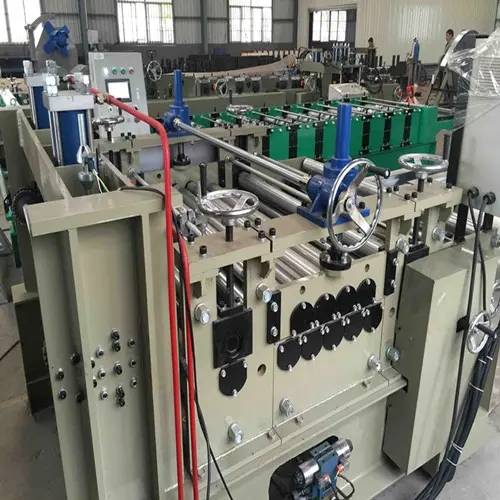
Understanding Wall Angle Roll Forming Machines
Roll forming is a highly efficient manufacturing process widely used in the production of various shapes and profiles, particularly in the construction and manufacturing industries. Among the various types of roll forming machines, the wall angle roll forming machine stands out due to its specialized function of producing wall angles, which are crucial components in the structural systems of buildings. This article explores the design, functionality, applications, and advantages of wall angle roll forming machines.
Design and Operation
A wall angle roll forming machine is designed to convert flat steel coils into angle profiles through a series of rollers. The process starts with feeding the cold-rolled steel strip into the machine. The machine consists of a set of rollers arranged sequentially, each performing a specific bending function. As the strip passes through these rollers, it gradually takes on the desired wall angle shape, which typically consists of two legs forming an L shape.
The dimensions of the wall angle—such as the length, thickness, and angle—can be customized according to specific project requirements. Advanced wall angle roll forming machines come equipped with programmable controls that allow for easy adjustments, enabling the production of different profiles without significant downtime.
Applications
Wall angle profiles produced by these machines are extensively used in the construction industry. They are primarily utilized in the following applications
1. Framing Systems Wall angles serve as vital components in metal stud framing, providing structural support for walls, ceilings, and partitions.
2. Suspended Ceilings They are essential for the installation of suspended ceilings, helping to create a stable framework for panels.
4. Decorative Elements In addition to structural applications, wall angles can also be used in decorative contexts, adding aesthetic appeal to building interiors and exteriors.

Advantages of Wall Angle Roll Forming Machines
Investing in a wall angle roll forming machine offers numerous benefits for manufacturers and contractors
1. High Efficiency Roll forming is a continuous process, which allows for the rapid production of wall angles. This high throughput helps reduce manufacturing time and costs.
2. Precision Engineering The automated nature of roll forming machines ensures consistent and precise dimensions, resulting in high-quality end products that meet specifications.
3. Material Optimization The process minimizes waste, as it can use full-width coils, allowing for better material utilization compared to other methods.
4. Versatility Modern machines can produce a wide range of wall angles and can easily switch between different profiles, making them adaptable to various project needs.
5. Durability The profiles created through roll forming are strong and resilient, making them suitable for both structural integrity and aesthetic functions in construction.
6. Reduced Labor Costs Automation reduces the need for manual labor, thus lowering overall operational costs.
Conclusion
The wall angle roll forming machine plays a crucial role in modern construction, enabling manufacturers to produce durable, precise, and cost-effective wall angles. As technology advances, these machines continue to evolve, incorporating smart features that enhance flexibility, efficiency, and production capability. By understanding the workings and advantages of wall angle roll forming machines, businesses can make informed decisions, optimizing their operations and contributing to the growth of the construction industry. Investing in this technology not only streamlines production but also meets the increasing demand for high-quality construction materials, ensuring structures' longevity and safety.